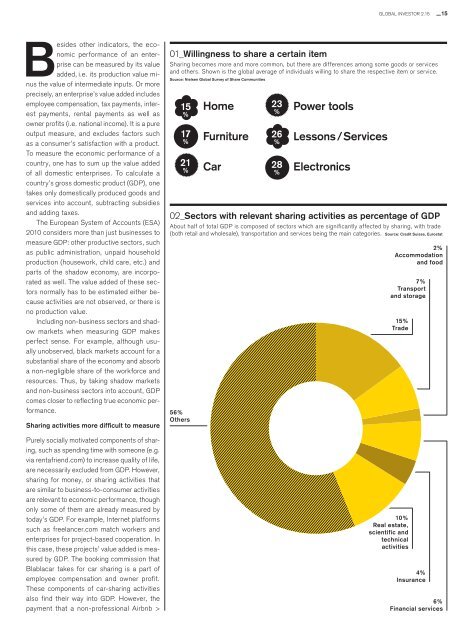The sharing economy
New opportunities, new questions Global Investor, 02/2015 Credit Suisse
New opportunities, new questions
Global Investor, 02/2015
Credit Suisse
Create successful ePaper yourself
Turn your PDF publications into a flip-book with our unique Google optimized e-Paper software.
GLOBAL INVESTOR 2.15 — 15<br />
Besides other indicators, the economic<br />
performance of an enterprise<br />
can be measured by its value<br />
added, i.e. its production value minus<br />
the value of intermediate inputs. Or more<br />
precisely, an enterprise’s value added includes<br />
employee compensation, tax payments, interest<br />
payments, rental payments as well as<br />
owner profits (i.e. national income). It is a pure<br />
output measure, and excludes factors such<br />
as a consumer’s satisfaction with a product.<br />
To measure the economic perform ance of a<br />
country, one has to sum up the value added<br />
of all domestic enterprises. To calculate a<br />
country’s gross domestic product (GDP), one<br />
takes only domestically produced goods and<br />
services into account, subtracting subsidies<br />
and adding taxes.<br />
<strong>The</strong> European System of Accounts (ESA)<br />
2010 considers more than just businesses to<br />
measure GDP: other productive sectors, such<br />
as public administration, unpaid household<br />
production (housework, child care, etc.) and<br />
parts of the shadow <strong>economy</strong>, are incorporated<br />
as well. <strong>The</strong> value added of these sectors<br />
normally has to be estimated either because<br />
activities are not observed, or there is<br />
no production value.<br />
Including non-business sectors and shadow<br />
markets when measuring GDP makes<br />
perfect sense. For example, although usually<br />
unobserved, black markets account for a<br />
substantial share of the <strong>economy</strong> and absorb<br />
a non-negligible share of the workforce and<br />
resources. Thus, by taking shadow markets<br />
and non-business sectors into account, GDP<br />
comes closer to reflecting true economic performance.<br />
Sharing activities more difficult to measure<br />
Purely socially motivated components of <strong>sharing</strong>,<br />
such as spending time with someone (e.g.<br />
via rentafriend.com) to increase quality of life,<br />
are necessarily excluded from GDP. However,<br />
<strong>sharing</strong> for money, or <strong>sharing</strong> activities that<br />
are similar to business-to-consumer activities<br />
are relevant to economic performance, though<br />
only some of them are already measured by<br />
today’s GDP. For example, Internet platforms<br />
such as freelancer.com match workers and<br />
enterprises for project-based cooperation. In<br />
this case, these projects’ value added is measured<br />
by GDP. <strong>The</strong> booking commission that<br />
Blablacar takes for car <strong>sharing</strong> is a part of<br />
employee compensation and owner profit.<br />
<strong>The</strong>se components of car-<strong>sharing</strong> activities<br />
also find their way into GDP. However, the<br />
payment that a non-professional Airbnb ><br />
01_Willingness to share a certain item<br />
Sharing becomes more and more common, but there are differences among some goods or services<br />
and others. Shown is the global average of individuals willing to share the respective item or service.<br />
Source: Nielsen Global Survey of Share Communities<br />
15<br />
%<br />
17<br />
%<br />
21<br />
%<br />
02_Sectors with relevant <strong>sharing</strong> activities as percentage of GDP<br />
About half of total GDP is composed of sectors which are significantly affected by <strong>sharing</strong>, with trade<br />
(both retail and wholesale), transportation and services being the main categories. Source: Credit Suisse, Eurostat<br />
56%<br />
Others<br />
Home<br />
Furniture<br />
Car<br />
23<br />
%<br />
26<br />
%<br />
28<br />
%<br />
Power tools<br />
Lessons / Services<br />
Electronics<br />
2%<br />
Accommodation<br />
and food<br />
7%<br />
Transport<br />
and storage<br />
15%<br />
Trade<br />
10%<br />
Real estate,<br />
scientific and<br />
technical<br />
activities<br />
4%<br />
Insurance<br />
6%<br />
Financial services

















